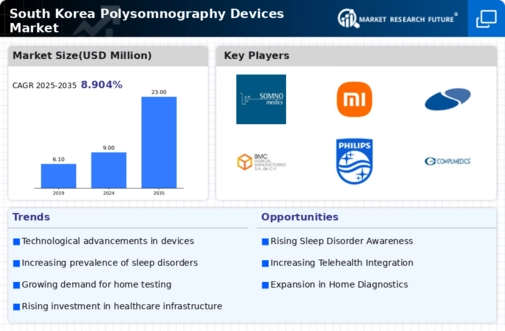Increased Healthcare Expenditure
The upward trend in healthcare expenditure in South Korea is another significant driver for the polysomnography devices market. The government has been progressively increasing its healthcare budget, which reached approximately $200 billion in 2025. This financial commitment is aimed at enhancing healthcare services, including sleep medicine. As a result, hospitals and clinics are more likely to allocate funds for advanced diagnostic equipment, such as polysomnography devices. Additionally, the private sector is also witnessing a surge in investments, with many healthcare facilities upgrading their technology to meet the growing demand for sleep studies. This increase in healthcare expenditure not only facilitates the acquisition of polysomnography devices but also encourages research and development in sleep medicine, further stimulating market growth. Therefore, the increased healthcare expenditure in South Korea is likely to have a positive impact on the polysomnography devices market.
Growing Awareness of Sleep Health
There is a notable increase in public awareness regarding the importance of sleep health in South Korea, which serves as a significant driver for the polysomnography devices market. Educational campaigns and initiatives by health organizations have highlighted the critical role of sleep in overall well-being. As a result, individuals are becoming more proactive in seeking diagnosis and treatment for sleep disorders. This heightened awareness is likely to lead to an increase in the number of sleep studies conducted, thereby driving demand for polysomnography devices. Furthermore, the rise of social media and online health platforms has facilitated the dissemination of information about sleep health, making it easier for the public to understand the implications of sleep disorders. Consequently, the growing awareness of sleep health appears to be a vital factor influencing the polysomnography devices market in South Korea.
Rising Prevalence of Sleep Disorders
The increasing incidence of sleep disorders in South Korea is a primary driver for the polysomnography devices market. According to recent health surveys, approximately 30% of the adult population experiences some form of sleep-related issues, such as insomnia or sleep apnea. This growing prevalence necessitates advanced diagnostic tools, including polysomnography devices, to facilitate accurate assessments and effective treatment plans. As awareness of sleep disorders rises, healthcare providers are likely to invest more in these diagnostic technologies, thereby propelling market growth. Furthermore, the aging population in South Korea, which is projected to reach 20% by 2025, is expected to contribute significantly to the demand for polysomnography devices, as older adults are more susceptible to sleep disorders. Thus, the rising prevalence of sleep disorders appears to be a crucial factor influencing the polysomnography devices market in the region.
Regulatory Support for Sleep Medicine
Regulatory support for sleep medicine in South Korea is emerging as a key driver for the polysomnography devices market. The government has been implementing policies aimed at improving sleep health and facilitating access to diagnostic services. For instance, recent regulations have streamlined the approval process for new medical devices, encouraging manufacturers to introduce innovative polysomnography solutions. Additionally, the establishment of sleep disorder clinics and specialized training programs for healthcare professionals indicates a commitment to enhancing sleep medicine. This regulatory support not only fosters a conducive environment for market growth but also ensures that patients receive timely and effective care. As a result, the regulatory landscape appears to be a significant factor influencing the polysomnography devices market in South Korea.
Technological Innovations in Diagnostic Tools
Technological innovations in diagnostic tools are significantly impacting the polysomnography devices market. The introduction of advanced features, such as wireless connectivity, portable devices, and enhanced data analytics capabilities, is transforming the landscape of sleep diagnostics. These innovations not only improve the accuracy and efficiency of sleep studies but also make it more convenient for patients to undergo testing in their own homes. As healthcare providers in South Korea adopt these cutting-edge technologies, the demand for polysomnography devices is expected to rise. Moreover, the integration of telemedicine with polysomnography allows for remote monitoring and consultations, further expanding the market potential. Therefore, the ongoing technological innovations in diagnostic tools are likely to play a crucial role in shaping the polysomnography devices market.




















Leave a Comment